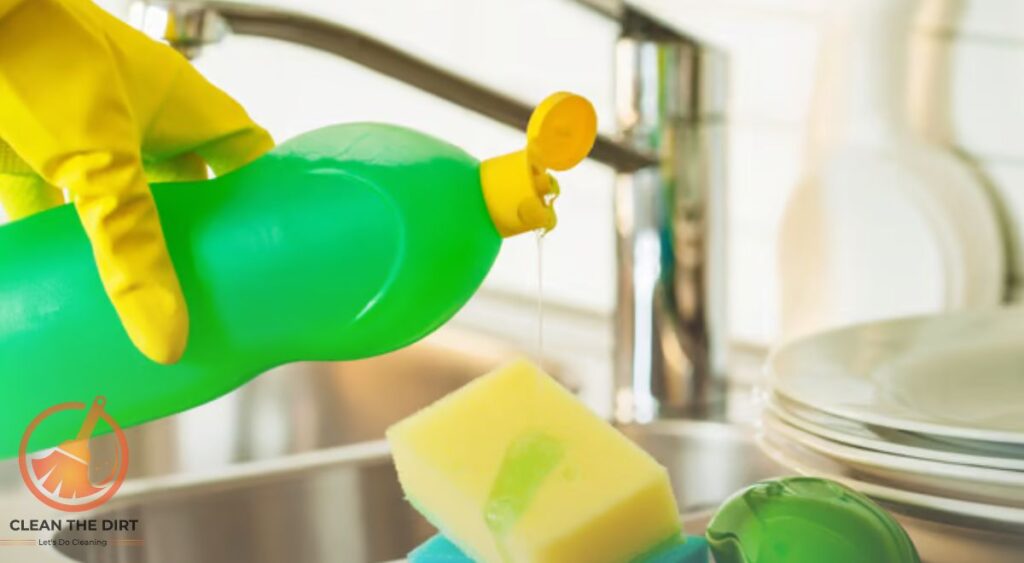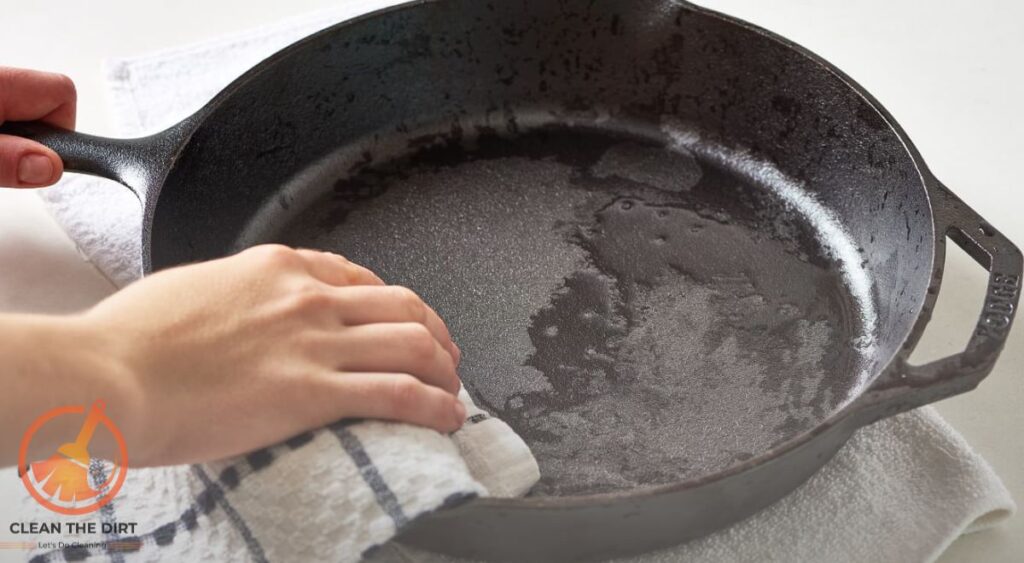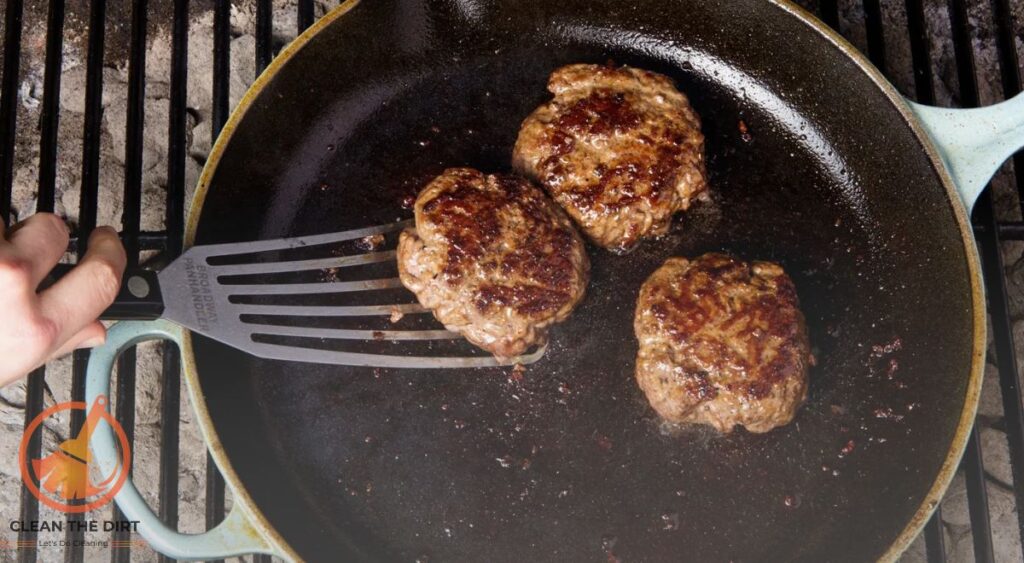Table of Contents
Introduction
Hello everyone in this guide on how to clean cast iron skillet after use. So, you’ve just finished whipping up a delicious meal in your trusty cast iron skillet. But wait, before you kick back and enjoy your culinary masterpiece, there’s one crucial step you can’t afford to skip which is how to clean cast iron skillet after use.
Whether you’re a seasoned home chef or just starting to explore the wonders of cast iron cooking, mastering the art of how to clean cast iron pan after use is essential for keeping your kitchen tools in top-notch condition. Not only does it ensure that your skillet remains free from stubborn food remnants, but it also plays a vital role in preserving its prized seasoning and preventing rust.
In this guide, we’ll walk you through the step-by-step process of how to clean cast iron skillet after use, sharing valuable tips and tricks along the way to help you maintain your kitchen favorite for years to come. So, be confident, and let’s dive into the wonderful world of cast iron care.
Understanding Cast Iron Skillets
Before we dive into the details of how to clean cast iron skillet after use, let’s take a moment to appreciate these timeless kitchen essentials.
Cast iron skillets are more than just cooking vessels and they’re culinary companions with a rich history and unparalleled versatility. Made from molten iron that’s poured into molds and cast into shape, these rugged pans boast excellent heat retention and distribution properties, making them ideal for everything from frying bacon to baking cornbread.
What sets cast iron skillets apart from their non-stick counterparts is their experienced surface, a natural, non-toxic layer of polymerized oil that forms over time with regular use and proper care. This seasoning not only prevents food from sticking but also imparts a unique depth of flavor to your dishes, making each meal a culinary adventure.
However, despite their durability and resilience, cast iron skillets require a bit of attention to keep them in perfect shape. This is where how to clean cast iron skillet after use comes into play. By understanding the unique properties of cast iron and the importance of proper maintenance, you’ll be well-equipped to make the most of your beloved skillet for many years.
Now that we’ve gained a newfound appreciation for these kitchen essentials, let’s roll up our sleeves and dive into the art of how to clean cast iron pan after use.
Materials Needed
Before we embark on our journey to learn how to clean cast iron skillet after use, let’s gather the essential tools and ingredients to ensure a successful cleaning session.
1. Hot Water
Start by adding hot water to a basin or your sink. The heat helps to loosen any stuck-on food particles, making them easier to remove.
2. Mild Dish Soap
While some purists prefer to skip the soap altogether, gentle dish soap can be handy for tackling stubborn residue without stripping away the skillet’s precious seasoning.

3. Brush or Sponge
Choose a soft-bristled brush or sponge to scrub away any remaining food debris without scratching the surface of your cast iron skillet.
4. Paper Towels or Cloth
Keep a stack of paper towels or a clean cloth on hand for drying your skillet after cleaning.
5. Vegetable Oil or Shortening
To maintain the skillet’s seasoning and prevent it from rusting, you’ll need a high-smoke-point oil such as vegetable oil or shortening for seasoning after cleaning.
With these simple yet essential materials at your disposal, you’re ready to tackle the problem of how to clean cast iron skillet after use with confidence and ease.
How to Clean Cast Iron Skillet After Use? Step-by-Step Cleaning Process
Now that we’ve gathered our materials, it’s time to roll up our sleeves and dive into the step-by-step process of how to clean cast iron skillet after use. Follow these simple instructions to keep your skillet sparkling clean and ready for your next culinary adventure.
1. Cool Down the Skillet
Allow your cast iron skillet to cool down slightly after cooking. Trying to clean a hot skillet can not only be risky but can also cause damage to the seasoning.
2. Scrape Away Food Residue
Using a spatula or a wooden spoon, gently scrape away any leftover food particles from the surface of the skillet. Be thorough but gentle to avoid scratching the seasoning.
3. Wash with Hot Water
Place the skillet under running hot water or dip it in a sink filled with hot water. Avoid using cold water, as it can cause thermal shock and potentially damage the skillet.
4. Add a Drop of Dish Soap
If needed, add a drop of mild dish soap to the hot water. According to people’s belief, a small amount of soap won’t harm the seasoning of your skillet and can help to remove stubborn residue.
5. Scrub with a Brush or Sponge
Using a soft-bristled brush or sponge, gently scrub the surface of the skillet to remove any remaining food debris. Pay extra attention to any stuck-on bits, but avoid using abrasive cleaners that can damage the seasoning.
6. Rinse Thoroughly
Once the skillet is clean, rinse it thoroughly under hot running water to remove any soap residue.
7. Dry Completely
Thoroughly dry the skillet with a fresh towel or paper towel. Ensure that no moisture remains on the surface, as it can lead to rust formation.

8. Apply a Thin Layer of Oil
To protect the skillet and maintain its seasoning, apply a thin layer of vegetable oil or shortening to the entire surface, including the handle and exterior. Use a paper towel to spread the oil equally and remove any excess.
By following these straightforward steps of the guide on how to clean cast iron skillet after use, you’ll be able to keep your cast iron skillet in fresh condition, ready to tackle any cooking task with ease. Now, onto the seasoning process to ensure your skillet stays seasoned and rust-free for a long period.
Additional Tips and Tricks
This comprehensive guide on how to clean cast iron skillet after use may seem straightforward, but there are some handy tips and tricks to ensure your skillet stays in new condition. Let’s explore a few.
1. Salt Scrub for Stubborn Stains
If you’re dealing with stubborn stains or stuck-on food residue, try using a salt scrub. Sprinkle kosher salt or coarse salt onto the surface of the skillet, then use a damp cloth or paper towel to scrub the salt into the affected areas. The abrasive texture of the salt helps to lift away stubborn stains without damaging the seasoning.
2. Vinegar Soak for Tough Residue
For particularly stubborn residue, consider soaking the skillet in a solution of equal parts water and white vinegar. Let the skillet soak for a few hours or overnight, then rinse and scrub as usual. The acidity of the vinegar helps to break down tough residue, making it easier to clean.
3. Avoid Soaking Overnight:
While soaking your skillet can help loosen stubborn residue, avoid leaving it dipped in water for extended periods, especially overnight. Long exposure to water can lead to rust formation and may damage the seasoning of your skillet.
4. Use Boiling Water for Burnt-on Messes
If you’ve accidentally burnt food onto your skillet, don’t panic, fill the skillet with water and bring it to a boil on the stovetop. The heat will help to loosen the burnt-on mess, making it easier to scrape away with a spatula or wooden spoon.
5. Re-season Regularly
To maintain the seasoning of your skillet and keep it rust-free, make sure to re-season it regularly. After cleaning and drying the skillet, apply a thin layer of oil to the entire surface and heat it in the oven or on the stovetop until it begins to smoke. This helps to refill the protective layer of seasoning and keeps your skillet in top condition.
By incorporating these additional tips and tricks into your cast iron skillet cleaning routine, you’ll be able to handle the issue of how to clean cast iron skillet after use with confidence. With a little care and attention, your skillet will continue to be a cherished kitchen companion for a long time.
Common Mistakes to Avoid
While how to clean cast iron skillet after use is a relatively short procedure, there are a few common mistakes that many people make. By avoiding these hitches, you can ensure that your skillet remains in top condition for many years. Let’s take a look.
1. Using Harsh Abrasives
One of the most common mistakes people make is using harsh abrasives, such as steel wool or metal scouring pads, to clean their skillet. These abrasive materials can scratch the surface of the skillet and strip away its precious seasoning. Instead, pick a soft-bristled brush or sponge to gently scrub away any food residue.
2. Skipping the Drying Step
Another common mistake is failing to dry the skillet thoroughly after cleaning. Moisture left on the surface of the skillet can lead to rust formation, undoing all of your hard work. Take the time to dry the skillet completely with a clean towel or paper towel before storing it.
3. Neglecting to Re-season
Re-seasoning your skillet regularly is essential for maintaining its seasoning and preventing rust. After cleaning and drying the skillet, be sure to apply a thin layer of oil to the entire surface and heat it in the oven or on the stovetop until it begins to smoke. This keeps your skillet in excellent shape and aids in reapplying the seasoning’s protective coating.
4. Using Soap Sparingly
Despite what many people think, a tiny bit of dish soap won’t ruin your skillet’s flavor. Actually, it can aid in getting rid of tough residue without removing the flavoring. However, be sure to use soap sparingly and avoid using harsh detergents that can damage the skillet.
By avoiding these common mistakes and following the proper cleaning and maintenance techniques mentioned in this guide on how to clean cast iron skillet after use, you can ensure that your cast iron skillet remains a cherished kitchen companion for years ahead.
Maintenance and Seasoning
Congratulations, you’ve successfully learned how to clean cast iron skillet after use and ensured it’s free from stubborn residue. But our journey doesn’t end there. Proper maintenance and seasoning are essential for keeping your skillet in prime condition for the coming years.
1. Regular Seasoning
Seasoning isn’t just a one-time affair, it’s an ongoing process that helps to maintain the integrity of your skillet’s surface. After cleaning and drying your skillet, it’s crucial to re-season it regularly to replenish the protective layer of seasoning. Apply a thin layer of oil to the entire surface of the skillet, including the handle and exterior, and heat it in the oven or on the stovetop until it begins to smoke. This helps to bond the oil to the surface, creating a durable and non-stick coating.
2. Storage Tips
When storing your cast iron skillet, be sure to place a paper towel or cloth between the skillet and its lid to prevent moisture buildup, which can lead to rust formation. Store the skillet in a cool, dry place away from direct sunlight to protect it from oxidation.
3. Avoiding Moisture
Moisture is the enemy of cast iron, so it’s essential to keep your skillet dry at all times. After cleaning, be sure to dry the skillet thoroughly with a clean towel or paper towel. If you notice any signs of rust forming, use a small amount of oil and a gentle abrasive, such as kosher salt, to remove the rust and re-season the skillet as needed.
4. Avoiding Acidic Foods
Acidic foods, such as tomatoes and citrus fruits, can strip away the seasoning of your skillet if left to sit for too long. While it’s okay to cook acidic foods in your skillet occasionally, be sure to clean the skillet promptly afterward and re-season it as needed to protect the surface.
5. Cooking Regularly
One of the best ways to maintain the seasoning of your skillet is to use it regularly. Each time you cook with your skillet, you’re adding another layer of seasoning, which helps to enhance its non-stick properties and durability.

By following these maintenance and seasoning tips, you can ensure that your cast iron skillet remains a cherished kitchen companion for generations to come. With proper care and attention, your skillet will continue to deliver delicious meals and memories.
Conclusion
And there you have it the complete guide on how to clean cast iron skillet after use. We’ve covered everything from gathering the essential materials to mastering the art of seasoning, ensuring that your skillet remains in top condition for years to come.
By following the simple yet effective steps outlined in this guide, you can keep your cast iron skillet sparkling clean and ready for your next culinary adventure. Remember to cool down the skillet before cleaning, use gentle scrubbing techniques, and always dry the skillet thoroughly to prevent rust formation.
Maintaining your skillet isn’t just about cleanliness. It’s about preserving its rich history and unparalleled cooking properties. With proper care and attention, your cast iron skillet will continue to be a cherished kitchen companion, serving up delicious meals and memories for generations to come.
Let’s have a look at the table showing the comparison of cast iron skillet and non-stick skillet.
| Aspect | Cast Iron Skillet | Non-Stick Skillet |
|---|---|---|
| Material | Made of cast iron, known for excellent heat retention and durability | Typically made with aluminum or stainless steel and coated with Teflon or ceramic for a non-stick surface |
| Heat Retention | Excellent heat retention and distributes heat evenly | Good heat retention, but may develop hot spots over time |
| Versatility | Can be used on all cooktops, including induction, and can also go from stovetop to oven | Limited to low to medium heat and stovetop use, not suitable for broiling or high-heat cooking |
| Durability | Highly durable and resistant to scratches and dents | Less durable, coating can scratch or chip with metal utensils |
| Non-Stick Properties | Develops a natural non-stick surface with proper seasoning and care | Relies on a chemical coating to create a non-stick surface, which may degrade over time |
| Maintenance | Requires regular seasoning and careful hand washing | Easy to clean and often dishwasher-safe, but may require replacement if coating wears off |
| Longevity | With proper care, can last a lifetime or even generations | Coating may wear off over time, requiring replacement every few years |
So, the next time you whip up a batch of crispy bacon or golden cornbread in your trusty skillet, take a moment to appreciate the care and attention that goes into keeping it in pristine condition. With a little effort and a lot of love, your cast iron skillet will reward you with a lifetime of delicious meals and culinary delights.
Frequently Asked Questions (FAQs)
Is it okay to use soap to clean a cast iron skillet?
Yes, it’s perfectly fine to use a small amount of mild dish soap when cleaning a cast iron skillet. Contrary to popular belief, a small amount of soap won’t harm the skillet’s seasoning and can help to remove stubborn residue.
Can I soak my cast iron skillet in water?
While soaking can help loosen stubborn residue, it’s best to avoid leaving your cast iron skillet submerged in water for extended periods, especially overnight. Prolonged exposure to water can lead to rust formation and may damage the skillet’s seasoning.
How should I dry my cast iron skillet after cleaning?
After cleaning, be sure to dry your cast iron skillet thoroughly with a clean towel or paper towel. Moisture left on the surface can lead to rust formation, so it’s essential to ensure the skillet is completely dry before storing it.
Do I need to re-season my cast iron skillet after every use?
No, you don’t need to re-season your cast iron skillet after every use. However, it’s essential to re-season it regularly to maintain its seasoning and prevent rust. After cleaning and drying the skillet, apply a thin layer of oil and heat it until it begins to smoke to re-season.
Can I use metal utensils on my cast iron skillet?
While cast iron skillets are durable, it’s best to avoid using metal utensils that can scratch the surface and damage the seasoning. Instead, opt for wooden or silicone utensils that are gentle on the skillet’s surface.
What should I do if my cast iron skillet develops rust?
If you notice rust forming on your cast iron skillet, don’t panic! Use a small amount of oil and a gentle abrasive, such as kosher salt, to remove the rust. Once the rust is removed, re-season the skillet to protect it from future rust formation.
Can I use my cast iron skillet on a glass cooktop?
While cast iron skillets are suitable for most stovetops, including gas and electric, they may not be compatible with glass or ceramic cooktops. The rough surface of the skillet can scratch the cooktop, so it’s essential to use caution or place a protective barrier between the skillet and the cooktop.
You May Also Like: How to Clean Rust Off Blackstone? Expert Tips for Restoring Your Grill’s Shine




